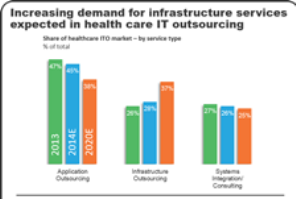Healthcare Cloud Computing $12.8 Billion by 2020
The global health care sector outlook for 2015 is mixed. Treatment advancements and government initiatives to increase access to care should drive sector expansion but pressure to reduce costs is escalating. Growing populations and consumer wealth are increasing demand for health care services but aging societies and chronic diseases are forcing health payers to make difficult decisions on benefit levels. In the midst of this tug-of-war, many historic business models and operating processes will no longer suffice. Read on to learn more about trends impacting the global health care sector in 2015 and suggested considerations for stakeholders. Four major trends are anticipated to impact stakeholders along the global health care value chain in 2015: cost, adapting to market forces, transformation and digital innovation, and regulations and compliance.
The global market for Healthcare Cloud Computing is projected to reach $12.8 billion by 2020 driven by changing healthcare economics in the wake of financial realities and that need for smarter healthcare management solutions. Growth in the market is also driven by other factors such as legislation of strict healthcare data compliance policies including:
Growing demand for HIPAA-compliant cloud
Increase in hospital BYOD
Emerging IoT everywhere in health related applications
Change is requiring providers and health plans to rethink traditional business models to better address shifting or emerging health care challenges and opportunities.
Increasing role of government – Governments’ pivotal – and growing – role as payer, regulator, and market-shaper in the global health care sector cannot be understated.
Scale to prosper – Converging market forces are setting the stage for what may be a period of rapid consolidation among health care providers, particularly in the U.S. Both vertical and horizontal consolidation has been increasing, despite heightened regulatory scrutiny. In addition, cross-sector convergence is expected to rise with the shift towards an “eco-system” of product and service providers.
Competition for talent – As their populations and health care needs grow both developed and developing countries are struggling to supply adequate numbers of trained, qualified health care professionals, especially physicians and nurses.
Improving access to care – Workforce shortages, patint location, lack of health care infrastructure in certain countries, and outdated facilities in both developed and developing markets are major contributors to health care access problems around the world.
Consumerism – Patients facing large deductibles and cost-sharing for medical treatments and services – including specialty pharmaceuticals and medical devices – are becoming more cost-conscious and more involved in their health care decisions.
The United States is the largest market worldwide. Asia-Pacific ranks as the fastest growing market with CAGR od 20.6% led by factors such as the rise in cloud ready Asian countries and focus on developing sustainable high quality care delivery models and the growing popularity of lean healthcare management.
Trends and Drivers:
Strict Healthcare Data Compliance in Cloud
Demand for HIPAA compliant cloud drives the demand for Community Healthcare Cloud.
Increasing BYOD in Healthcare environment leads to new opportunity for Healthcare Cloud.
Encryption and Multi-Factor Authentication encourage the use of Public Healthcare Cloud.
Big Data Healthcare Analytics spurs the adoption of Infrastructure as a Service (IaaS)
Legacy systems will slowly transition to Cloud Infrastructure
Adoption of new digital HIT advances such as electronic health records, mHealth, telemedicine and predictive analytics is transforming the way physicians, payers, patients, and other health care stakeholders interact. Digital innovations like additive manufacturing, artificial intelligence, diagnostic devices and wearables are helping to facilitate new diagnostic and treatment options, increase process efficiency, and reduce costs. Technology advancements are also connecting developed and emerging markets — and participants along the health care value chain. These changes may be rapid and, in some parts of the world, disruptive to established health care models. However, their potential to improve the care process is already being seen.
Category: Uncategorized

